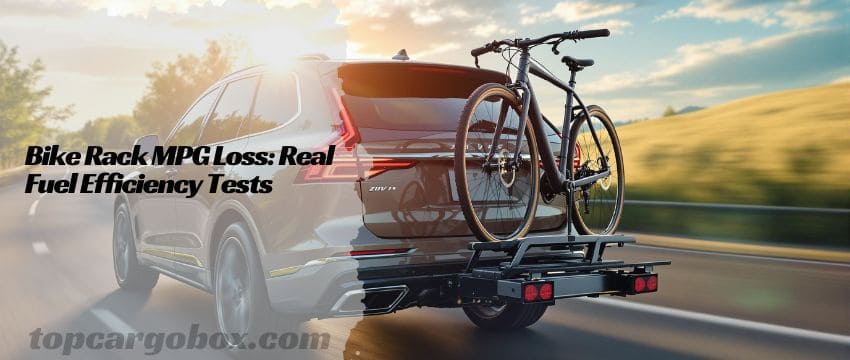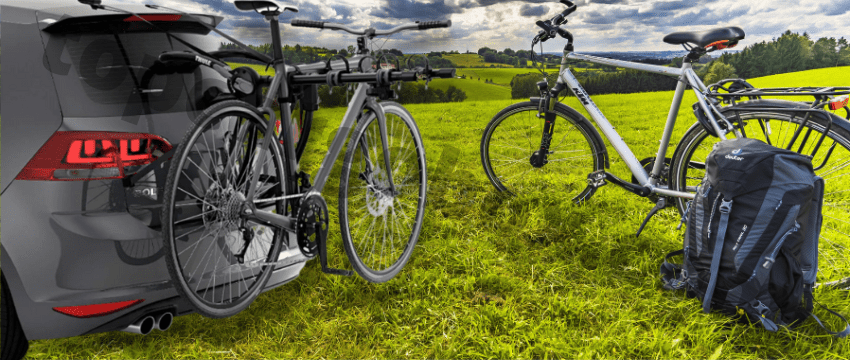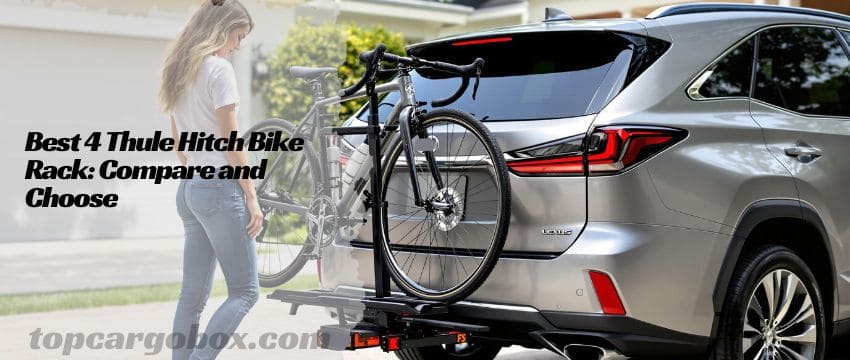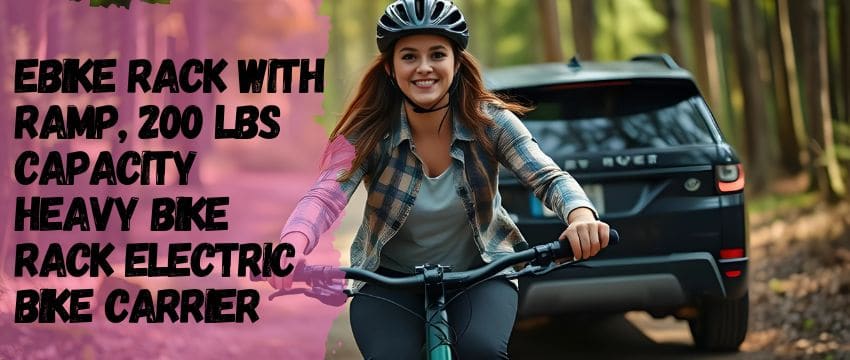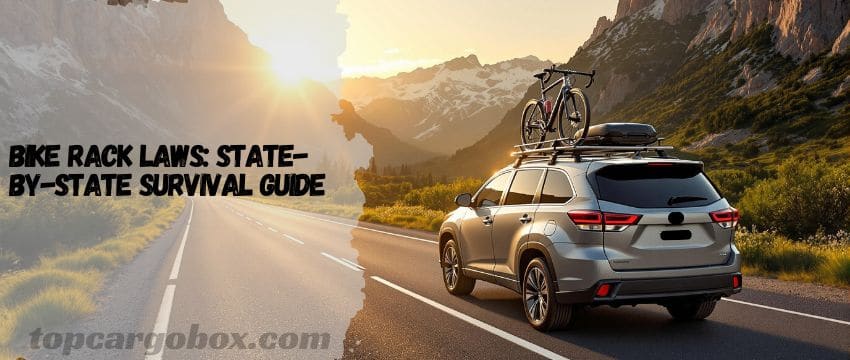What’s up, fellow adventurer? Ever packed the bikes, hit the highway, and then watched your fuel gauge drop way faster than usual? Yeah, that sinking feeling is legit. You planned this awesome trip, the trails are calling, but suddenly you’re wondering if you need to take out a small loan just for gas money. How much MPG do you really lose with a bike rack? Is it just a minor annoyance or a serious budget-buster? Let’s dive deep, ditch the guesswork, and get some real answers based on how things actually work on the road. Forget generic estimates; we’re talking real-world testing, the science behind the sip, and how to keep more cash in your pocket. Sound good? Let’s roll.
Why Your Bike Rack is a Gas Guzzling Secret Agent
Okay, let’s break this down. Your car’s engine works to overcome two main enemies: rolling resistance (tires on pavement) and aerodynamic drag (pushing air out of the way). At slow speeds, rolling resistance rules. But once you hit the highway? Aerodynamic drag becomes the BIG boss, responsible for the majority of your engine’s workload. It’s all about slicing through that invisible wall of air as efficiently as possible.
Now, picture slapping a big, clunky bike rack onto your car. It’s like throwing a giant parachute out the back or strapping a sail to your roof. Seriously! Instead of the air flowing smoothly over your car’s carefully designed shape, it hits this awkward obstruction. Turbulence happens. Air gets chaotic, swirling and creating pockets of low pressure that literally suck your car backwards. Your engine has to grunt way harder just to maintain the same speed. More work = more fuel burned. It’s physics, plain and simple. Think about sticking your hand out the window at 60 mph – feel that powerful push? Now imagine that force multiplied across the entire surface area of your bike rack and bikes. That’s the drag tax you pay.
Where the rack sits makes a HUGE difference in how much havoc it wreaks. A rack tucked close behind your car (like many hitch racks) disturbs the airflow less dramatically than bikes perched high up on the roof, acting like giant wind catchers. Even a trunk rack, while lower, still messes with the airflow pattern off the rear of your vehicle. Ever heard that loud whistling or buffeting noise once you hit cruising speed? That’s the sound of your MPG screaming for mercy. It’s not just the rack itself; those chunky tires, flat handlebars, and frame triangles on your bikes are basically little drag factories. The more bikes you add, the bigger the aerodynamic mess. It’s a compounding problem. Bummer, right?
Putting Hitch Racks to the MPG Test: The Good, The Bad, The Drafting Effect
Hitch racks are super popular, and for good reason. They’re often easier to load than roof racks, keep your bikes safe from low garage clearances, and many let you access the trunk without unloading everything. But how do they stack up at the pump? Real-world testing shows they generally cause less MPG loss than roof racks, but “less” doesn’t mean “none.” Expect a hit, but the severity depends heavily on the design of the rack and how many bikes you’re hauling.
Platform-style hitch racks (where bikes sit on trays, wheels secured) tend to be more aerodynamic than hanging racks (where bikes dangle by their top tubes). Why? Platform racks hold the bikes lower and often closer to the vehicle, allowing air to flow under the bikes more easily. Hanging racks position bikes higher, creating a bigger, blockier profile. Think of it like the difference between a sleek speedboat hull and a barge. Testing often reveals platform racks cause roughly 10-20% less drag than comparable hanging racks. That translates directly to better MPG. Brands like Thule and Yakima invest heavily in wind tunnel testing for their platform designs – it’s not just marketing fluff! Check out the sleek profiles on options like the Thule T2 Pro XTR or the Yakima RidgeBack – those shapes are fighting drag for you.
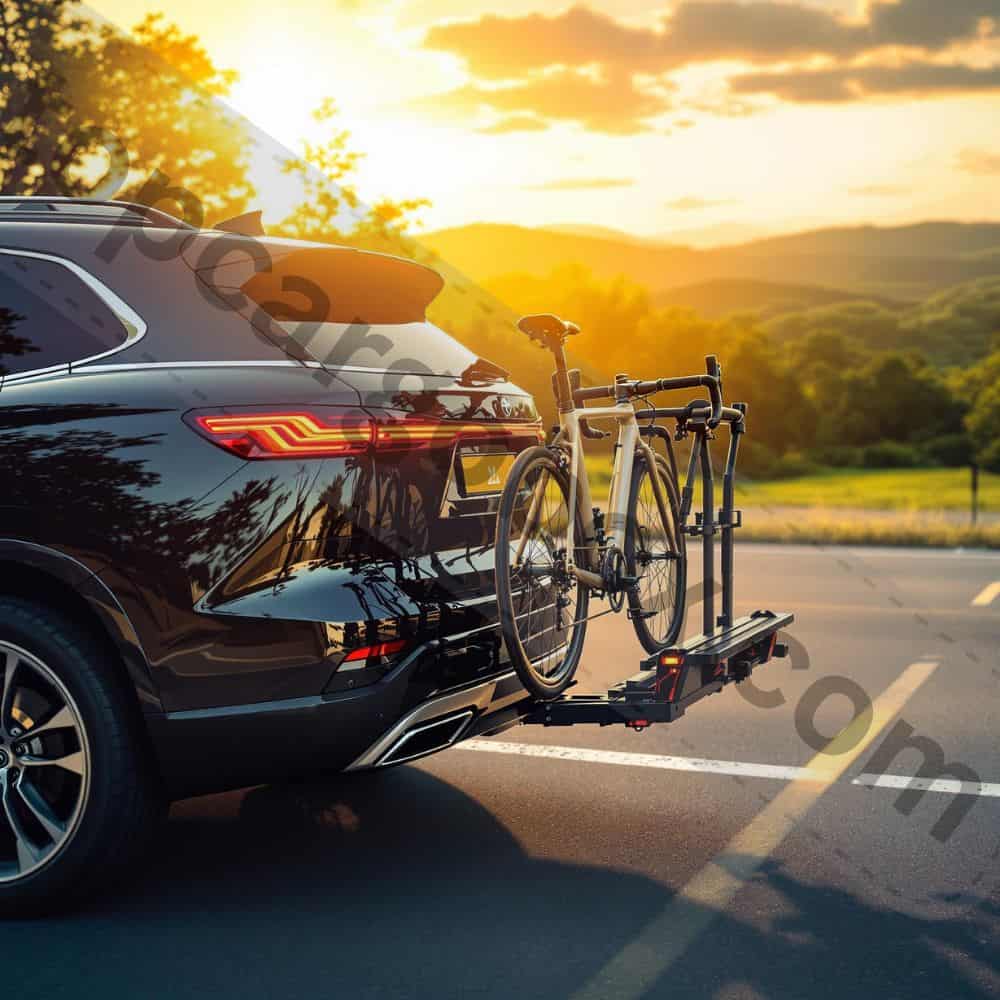
Number of bikes is the other massive factor. Hauling one bike on a platform rack might only ding your highway MPG by 5-10%. Add a second bike? Now you’re likely looking at 10-18% loss. Load up that 4-bike rack? Hold onto your wallet, because 20-30% (or even more on less aerodynamic vehicles or racks) is totally possible. The MPG penalty doesn’t scale linearly; adding each subsequent bike often increases drag disproportionately. That fourth bike really hurts! Also, consider the “drafting effect.” Hitch racks benefit somewhat from being in the wake of your vehicle. Airflow behind a car is already messy, so adding a rack within that turbulent zone has less relative impact than sticking something way up in the clean airflow over the roof. It’s still a drag, but slightly less so than being on top. Keeping bikes close to the vehicle is key for any rack type.
Roof Racks: The Ultimate MPG Killers (But They Have Their Perks)
Alright, let’s talk about the elephant on the roof. Roof-mounted bike racks are notorious fuel efficiency vampires. There’s just no sugar-coating it. Why? They place your bikes directly into the fastest, cleanest, most critical airflow zone on your entire vehicle. Remember how we said aerodynamic drag is the highway enemy? Well, the roof is ground zero for that battle. Air hitting the front of your car accelerates up and over the windshield and roof. Anything you stick up there – crossbars, a roof box, or bikes – disrupts this flow catastrophically.
Think of your bike as a vertical wall catching wind. The upright fork, the flat handlebars, the frame tubes – it’s a recipe for massive turbulence and drag. Real-world tests consistently show roof bike carriers cause the most significant MPG drop, often ranging from 15% to a staggering 30% or more on the highway. Yikes! Even just the empty crossbars themselves can cost you 2-5% in MPG – they’re creating drag before you even add the bike carriers! Adding one bike might mean a 15-20% loss. Two bikes? Easily 20-30%. It gets ugly fast. The higher your vehicle (think SUVs and trucks), the worse it often is, as the bikes are even further up in the stronger wind stream.
So why do people use them? Fair enough, they have advantages. You retain full use of your hitch for trailers or don’t have a hitch at all. They keep bikes completely clear of rear impacts (mostly) and exhaust fumes. They’re super secure when installed correctly. But the fuel cost is their biggest, undeniable downside. If you’re planning a long road trip, that MPG hit adds up fast. For frequent travelers, the convenience might not outweigh the literal hundreds of dollars extra you could spend on gas over a season. It’s a serious trade-off to consider. Is that sleek look worth watching your gas gauge plummet? You decide.
Trunk Racks: The Budget-Friendly MPG Middle Ground?
Trunk (or hatch) mounted racks are the old-school, often most affordable entry point into bike hauling. They strap onto your trunk lid or hatch using a web of belts and hooks. Convenient? Usually. Kind to your MPG? Well, it’s complicated.
On the plus side, trunk racks position the bikes relatively low, near the rear bumper. This means they partially benefit from being in the vehicle’s wake zone, similar to hitch racks, though usually not as effectively since they might sit slightly higher and further back. Generally, they cause less drag than roof racks but often more than a sleek hitch platform rack. Expect highway MPG losses in the ballpark of 10% to 25%, heavily influenced by the number of bikes, the specific design of the rack, and your car’s shape.
Here’s the big “but”: Stability and wobble are major concerns. Trunk racks rely entirely on straps and tension. At highway speeds, especially with two or more bikes, they can wobble and sway significantly. That wobble isn’t just nerve-wracking; it’s aerodynamically TERRIBLE. Imagine your bikes constantly shaking back and forth – it massively increases the turbulent wake behind your car, which means even more drag and potentially worse MPG than a stable hitch rack. A wobbly rack is an inefficient rack. Check out our deep dive on Trunk vs Hitch Racks: Which Wobbles Less? for the full lowdown on stability. Also, trunk racks can block your taillights and license plate (a big legal no-no in many places – know your Bike Rack Laws State by State), and accessing your trunk usually means unloading all the bikes. For occasional, short trips with one or two bikes, they can be okay, but for efficiency and stability, hitches usually win. If you must go trunk, look for the most robust designs like certain Thule models.
Beyond the Rack: What Makes the MPG Loss Worse (Or Better)?
It’s not just about the type of rack. Several other factors crank up (or dial down) the MPG penalty:
- Speed is KING (or the Executioner): This is HUGE. Aerodynamic drag increases exponentially with speed. Driving 70 mph creates way more than double the drag of driving 50 mph. Seriously! So, while you might lose only 5% MPG with a hitch rack at 50 mph, that same setup could easily cost you 15-20% at 75 mph. Slowing down is the SINGLE most effective way to fight bike rack fuel loss. Ease off the gas pedal, enjoy the ride, and save serious cash. Every 5 mph over 60 you drive significantly increases the drag tax.
- Your Vehicle Matters… A Lot: A big, boxy SUV or truck already has higher aerodynamic drag than a sleek sedan. Adding a bike rack amplifies that existing inefficiency. Vehicles with poor base MPG will see a larger absolute fuel consumption increase, even if the percentage loss is similar. A hybrid or super-efficient small car might see a heartbreakingly large percentage drop because its baseline consumption is so low. Also, the vehicle’s shape affects how cleanly air flows around the rack. A rack on a vehicle with a steeply raked rear window might perform better than the same rack on a flat-backed vehicle.
- Bike Loadout = Wind Resistance: It’s not just the number of bikes. Mountain bikes with wide, knobby tires and flat handlebars are WAY less aerodynamic than skinny-tired road bikes with drop bars. A cargo bike or a bike with bulky panniers still attached? Forget about it – that’s maximum drag city. Even how you position the bikes matters – inward-facing wheels generally create less drag than outward-facing. Think “sleek” when loading up.
- Rack Design Nuances: We touched on platform vs. hanging hitches. But also, does the rack have a fairing? Some roof boxes and front bars do, helping smooth airflow. How far do the bikes stick out? Racks that hold bikes closer to the vehicle are better. Are the rack arms and frames bulky or slim? Every little bit of metal or plastic sticking into the wind costs you pennies (or dollars) per mile.
Bike Rack MPG Impact Summary Table:
Feature | Impact on MPG Loss | Notes |
|---|---|---|
Rack Type | ||
Roof Mount | Highest Loss (15% – 30%+) | Bikes in cleanest, fastest airflow. Loss increases dramatically with each bike added. |
Trunk Mount | Moderate-High Loss (10% – 25%) | Lower position helps, but wobble increases drag. Stability is key. |
Hitch Mount (Hanging) | Moderate Loss (12% – 25%) | Higher profile than platforms. More drag per bike. |
Hitch Mount (Platform) | Lowest Loss (5% – 20%) | Sleekest profile, bikes held low & close. Best choice for minimizing MPG impact. |
Number of Bikes | Significant Increase | Each bike adds drag, but not linearly. The 3rd/4th bike hurts disproportionately more. |
Driving Speed | Exponential Increase | Biggest factor you control. Losses soar dramatically above 60 mph. Slow down! |
Vehicle Type | Amplifies Existing Drag | Boxier vehicles (SUVs, trucks) see larger absolute losses. Efficient cars see larger % drops. |
Bike Type/Accessories | Noticeable Increase | MTBs > Road Bikes. Panniers/baskets add significant drag. Position bikes inward-facing if possible. |
Rack Design Details | Moderate Influence | Fairings help. Protrusion distance matters. Slimmer arms/frames better than bulky ones. |
Real-World MPG Loss Scenarios: What Does This Mean for YOUR Wallet?
Okay, enough theory. Let’s talk cold, hard cash and gallons burned. How does this actually play out on your next trip? Let’s crunch some very realistic numbers. Remember, these are estimates based on common test results and averages – your exact loss will vary!
- Scenario 1: Weekend Warrior (Hitch Platform, 2 Bikes)
- Your Car: Gets 30 MPG highway normally.
- Estimated MPG Loss: 15%
- Trip MPG: 30 MPG * 0.85 = 25.5 MPG
- Trip Distance: 200 miles round trip
- Gas Used Normally: 200 miles / 30 MPG = 6.67 gallons
- Gas Used With Rack: 200 miles / 25.5 MPG = 7.84 gallons
- Extra Gas Used: 1.17 gallons
- Cost (@ $3.50/gal): $4.10
- Verdict: Annoying, but manageable for a short trip. You might not even notice the extra few bucks at the pump.
- Scenario 2: Family Adventure (Hitch Platform, 4 Bikes)
- Your Car (SUV): Gets 22 MPG highway normally.
- Estimated MPG Loss: 25% (4 bikes is a big load!)
- Trip MPG: 22 MPG * 0.75 = 16.5 MPG
- Trip Distance: 500 miles round trip
- Gas Used Normally: 500 miles / 22 MPG = 22.73 gallons
- Gas Used With Rack: 500 miles / 16.5 MPG = 30.30 gallons
- Extra Gas Used: 7.57 gallons
- Cost (@ $3.50/gal): $26.50
- Verdict: Ouch! That’s a significant extra cost. Suddenly that family trip just got more expensive. You feel this one.
- Scenario 3: The Roof Rack Road Trip (Roof, 2 Mountain Bikes)
- Your Car (Wagon): Gets 28 MPG highway normally.
- Estimated MPG Loss: 25%
- Trip MPG: 28 MPG * 0.75 = 21 MPG
- Trip Distance: 1000 miles round trip
- Gas Used Normally: 1000 miles / 28 MPG = 35.71 gallons
- Gas Used With Rack: 1000 miles / 21 MPG = 47.62 gallons
- Extra Gas Used: 11.91 gallons
- Cost (@ $3.50/gal): $41.69
- Verdict: That’s crazy! Over forty bucks extra just in gas. This is where the roof rack penalty really bites. Imagine doing this multiple times a summer?
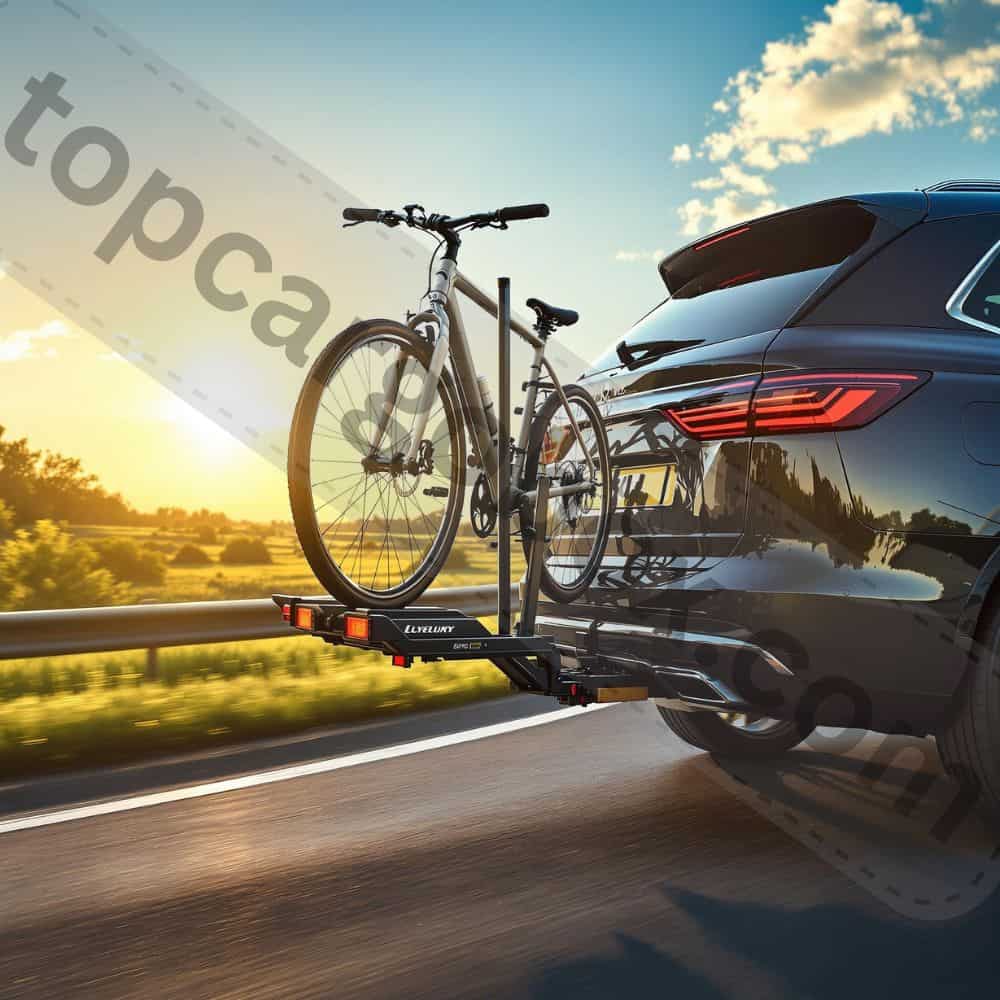
See how quickly it adds up? Especially on longer trips or with more bikes/less efficient racks. That extra $25-$40 might mean fewer post-ride beers or skipping that cool souvenir. Or worse, blowing your travel budget before you even get there! I get it – nothing kills the adventure vibe like watching your gas money disappear. Who knew hauling your fun could cost so much just in wind resistance?
Smart Strategies: How to Fight Back and Save Your MPG
Alright, feeling a bit bummed about those numbers? Don’t sweat it! You have real power to minimize the pain. It’s not just about accepting the loss; it’s about fighting back smartly. Here’s how to keep more money in your gas tank:
- Slow Your Roll (Seriously, This is #1): We hammered this point, but it bears repeating. Reducing speed is your absolute best weapon. Try sticking to 65 mph instead of 75 mph. You’ll be amazed at the difference. Not only do you save gas directly from lower speed, but you dramatically reduce the aerodynamic penalty from the rack. It’s a double win! Bonus: It’s safer and less stressful. Chill out, enjoy the scenery.
- Choose the Right Rack for Your Life: Be honest about your needs. If you take frequent long trips or haul multiple bikes, investing in a sleek hitch platform rack (like the Thule options we compare or the Yakima RidgeBack) will pay off in fuel savings over time compared to a roof or hanging hitch rack. The upfront cost might be higher, but the gas savings add up. If you rarely haul bikes, maybe a trunk rack suffices, knowing you’ll take the MPG hit on those few occasions. Consider a hitch mount like the MaxxHaul if budget is tight but you want better stability than a trunk.
- Remove the Rack When It’s Not Bike Time: This seems obvious, but so many people leave racks on for weeks or months “just in case.” Even an empty hitch rack or crossbars create measurable drag (2-8% MPG loss!). Get into the habit of taking it off when you know you won’t need it for a while. Yeah, it’s a minor hassle, but think of the gas you’re burning for absolutely zero benefit. Every little bit helps!
- Load Smart, Drive Smart: Position bikes as close to the vehicle and as low as possible. Face wheels inward. Remove unnecessary accessories like panniers or baskets before travel. Ensure everything is tightly secured to minimize wobble. Use cruise control on flat highways to maintain steady speed. Anticipate traffic to avoid unnecessary braking and accelerating. Combine trips – maybe that grocery run can happen on the way back from the trailhead?
- Vehicle TLC: Don’t neglect the basics. Under-inflated tires increase rolling resistance. A dirty air filter makes your engine work harder. Getting regular tune-ups keeps your engine running at peak efficiency. You want your car fighting the rack drag, not fighting its own problems too.
Implementing even a few of these can make a noticeable dent in your fuel costs over a season of adventures. It’s about being mindful, not militant. Save gas, save money, ride more. That’s the goal!
The Bigger Picture: Is the MPG Loss Worth It?
So, we’ve established that bike racks suck gas. Sometimes a lot. The million-dollar question: Does that mean you should leave the bikes at home? Heck no! Well, probably not. It’s all about perspective and priorities.
Think about the freedom that rack provides. It enables epic road trips to legendary trails, spontaneous weekend getaways, exploring new bike parks with friends, or just easily getting to your local singletrack without cramming bikes inside your car (scratched interiors, anyone?). That freedom, those experiences, the pure joy of riding in new places – that’s priceless. The gas cost is literally the price of admission for those adventures. When you frame it like that, an extra $20 or $40 on gas for a trip seems like a pretty fair trade, right?
Compare it to other “fun” costs. A single lift ticket at a bike park can easily cost $50-$70. A nice post-ride dinner and beers for two? $60+. A new bike jersey? $50+. Suddenly that $30 in extra gas for a weekend trip doesn’t look so bad in the grand scheme of your hobby budget. It’s about allocating your funds to what brings you joy.
The key is being informed and smart. Knowing how much you might lose lets you budget for it. Using the strategies we talked about helps you minimize that loss, making the trade-off even more worthwhile. Don’t let the MPG hit surprise you or ruin your vibe. Factor it in, drive efficiently, choose the right gear, and then go enjoy the ride without guilt. The trails (or roads) are calling! Totally worth a few extra gallons.
Conclusion: Knowledge is Power (and Savings!)
So, dude, there you have it. The cold, hard truth about bike racks and MPG, laid bare. They will cost you fuel efficiency – anywhere from a slight dip of 5% to a massive drain of 30% or more, depending on the rack type, number of bikes, your speed, and your vehicle. Roof racks are the biggest offenders, sleek hitch platforms are the best bet for efficiency, and trunk racks fall somewhere in the middle but bring wobble concerns. Speed is your biggest controllable factor – slow down and save big bucks.
But here’s the empowering part: Now you know. You understand why it happens (blame the drag monster!). You have realistic estimates of how much it might cost you on your next trip. Most importantly, you have a toolbox of strategies to fight back and keep more cash for post-ride burritos and new bike parts. Choose the right rack for your needs, take it off when not in use, load smart, drive smart, and keep your vehicle tuned up.
Don’t let the fear of MPG loss stop your adventures. Just be smart about it. Factor the extra gas cost into your trip budget, use the tips here to minimize the hit, and then go have an absolute blast on your bike. The wind in your face (not the wind dragging on your rack) is what it’s all about. Go get it!
Your Burning Bike Rack MPG Questions, Answered
How much does a bike rack affect MPG?
Honestly, it varies wildly! You could see as little as 5% loss with one road bike on a sleek hitch platform at moderate speeds. But load up four mountain bikes on your roof rack and blast down the highway at 75 mph? 30% or more loss is totally possible. The average for a typical 2-bike hitch setup is often 10-18% on the highway. The big factors are rack type (roof = worst), number of bikes, your driving speed (faster = much worse), and your vehicle’s shape. It’s never zero, but smart choices can keep it manageable. Don’t forget even an empty rack or crossbars cost you a few MPG!
How much MPG do you lose with a cargo box?
Cargo boxes (like those Thule or Yakima roof pods) are similar to roof bike racks in their MPG impact, sometimes slightly better if they are very aerodynamic. Expect highway losses in the range of 15% to 25%, depending heavily on the box size, shape, how full it is, your vehicle, and your speed. A big, bulky box on a tall SUV at high speed will hurt the most. Sleek, low-profile boxes designed in wind tunnels perform better but still cause significant drag. Like bike racks, speed is the killer – slowing down dramatically reduces the penalty.
How much does a roof rack reduce fuel efficiency?
Just the bare crossbars? You might lose 2% to 5% MPG on the highway – it’s noticeable but not huge. The real pain starts when you add carriers. Empty bike or ski carriers add some drag too. But load it up? A roof rack with bikes or a cargo box is often the worst offender, causing 15% to 30%+ MPG loss at highway speeds. This happens because it places the load right in the fastest, cleanest airflow over your car, creating massive turbulence and drag. The higher your vehicle, the worse it usually is. For fuel efficiency, roof mounting is generally the least desirable option.
Our team is creating outdoor-gear relevant articles with passion. If our articles can help you to find the correct solutions for your questions, we will be happy about that. In the content creation process, we usually collect accurate and useful information online or offline to compile our content in an organized way. Consequently, we can guarantee that you can discover some expected answers to your questions. We appreciate your time on our site.

